- Kia ora
- Southern section of shared path now open
- Inspiring the next generation with the Wonder Project
- New SH1 road layout north of Ōtaki
- Waopukatea
- The importance of planting alongside PP2Ō
- We're seeking your time capsule submissions
- Upcoming construction milestones
 Kia ora
Kia ora
Welcome to the October edition of the PP2Ō Expressway construction update – Express Connect.
This month we had the opportunity to update the community at three different events. The Community Liaison Group was held at the beginning of the month followed by the Southern Neighbourhood Group and Northern Neighbourhood Group the following week. It’s great to meet community members and listen to feedback from local residents and motorists who will be using the Expressway on a daily basis. We are always looking for ways to make things safer and more efficient for road users and the wider community, so we do appreciate when people provide us with constructive feedback. I thank the community for their continued support and active participation throughout this important project.
Despite the challenges we’ve faced with COVID-19 restrictions lately, October was a productive month on the project with a few milestones achieved. Earlier this month, we switched traffic onto the temporary northbound lane at the northern end of the project to allow our construction team to complete works at the northern end of the Expressway, north of Ōtaki. There’s a 50km/h speed limit in place, please adhere to the speed limit and be mindful of our people working in the area. We also completed the demolition and removal of the old Ōtaki Gorge Road Railway Bridge, and earthworks for the construction of the new off-ramp are progressing well.
The much-anticipated southern section of the shared path opened to pedestrians and cyclists at the very end of October. This will benefit local residents, as well as the wider community, by eliminating the risk of cyclists riding on the shoulder of SH1 and improving safety for everyone along the busy arterial corridor. News that the 1.2 kilometre section is open will no doubt be welcomed by residents of Waikanae, Peka Peka, Te Horo and further afield who have been eagerly waiting for this section of the pathway to be finished. The extension of the shared path from Peka Peka towards Ōtaki is designed to make cycling and walking around the Kāpiti Coast much easier and safer in the future. I’d just like to remind everyone though that the shared path is still within our construction zone, so please stick to the path and observe the signs. We’re also restricting the path to cyclists and pedestrians at this stage (i.e. no horses) so we can give the grass strip for equestrian riders an opportunity to establish.
COVID-19 rules remain in place throughout the project. We continue to be diligent with our contact tracing and urge everyone visiting our sites to wear masks and sign in either electronically or manually.
If you need any further information on the PP2Ō Expressway Project please visit our website www.nzta.govt.nz/pp2o(external link) (where you can sign up for digital updates), call us on 0800 PP2O INFO or email pp2o@nzta.govt.nz.
Ngā mihi,
Chris Hunt, Project Director
Southern section of shared path now open
In April 2018, Waka Kotahi NZ Transport Agency confirmed that a shared path would form part of the PP2Ō Expressway project. Since then, we’ve been working hard from the initial detailed design stage to the current construction stage for the 10 kilometre-long route. The shared path will provide the community with a safer multi-modal trail separated from cars, trucks and other motor vehicles.
We are pleased to share with you that the first 1.2 kilometres of the shared pathway is now open for cyclists and pedestrians to enjoy. At this time, we’re asking equestrians to please be patient and keep their horses off the path – this will give the recently-sown grass time to establish. The open section of the shared path will take you from Te Kowhai Road to Te Hapua Road, Peka Peka. For safer journeys to the north, and to avoid cycling on the shoulder of SH1, we encourage cyclists to turn into Te Hapua Road and continue along Derham and Pukenamu Roads.
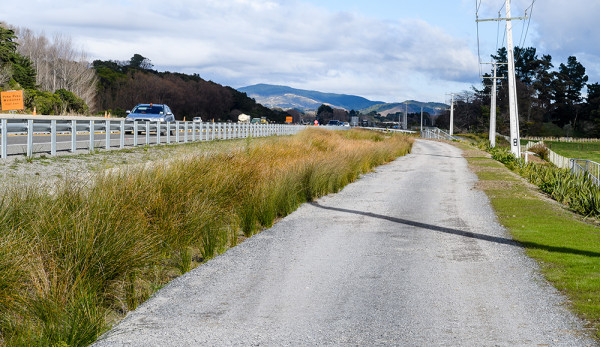
Shared path at southern end of alignment near Te Hapua Road - looking south.
Inspiring the next generation with the Wonder Project
The Wonder Project is a series of hands-on activities designed to spark wonder and curiosity in young kiwis and get the next generation excited about a career in science, technology, engineering and maths (STEM).
Here at the PP2Ō project, we have our own Wonder Project ambassador. Infrastructure Site Engineer, Lincoln Timoteo, has been volunteering with Engineering New Zealand to deliver their “Rocket Challenge” to Ōtaki College students. It’s free for schools and supported by STEM professionals all over New Zealand.
We love being able to involve young people in the work that we do. Who knows where this interest may lead them in their careers?
Watch the video below and learn more about this fantastic programme.
New SH1 road layout north of Ōtaki
On October 6th, the PP2Ō project team successfully opened the temporary northbound lane to the public at the diversion north of Ōtaki. With vehicles in both directions now using the new diversion, it’s a bit of a change - especially for those who don’t use the road regularly - so please take extra care while everyone gets used to the new road layout and keep to the speed limits in the area. The new road layout has a 50km/h temporary speed restriction in place. This is there for the safety of everyone, including you and our workers, so please stick to the speed limit at all times.
This is a great milestone as it will allow us to complete the Expressway tie-in works (connecting the new expressway with the existing state highway) at the northern end of the project.
We thank everyone for their patience as we continue our work on PP2Ō.
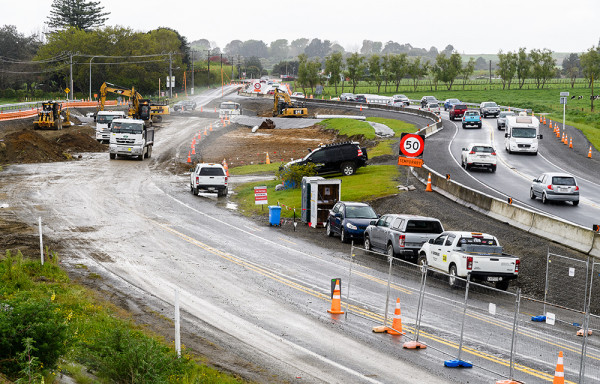
SH1 diversion at northern tie in area near Taylors Road.
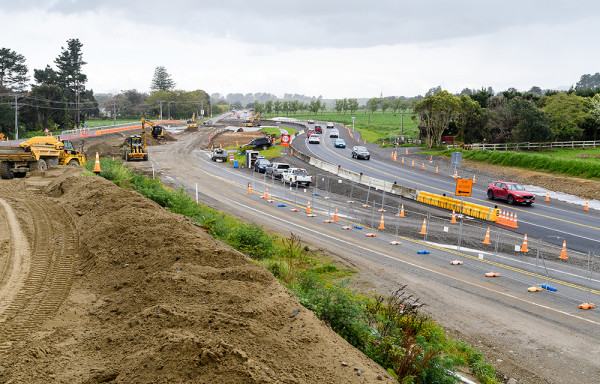
Northern tie in area near Taylors Road.
Waopukatea

Heading south on the expressway, under Ōtaki Gorge Road, you will encounter Waopukatea, which acknowledges the land block that Ōtaki Gorge Road and the bridge is located on, and the vegetation connected with the region. In the centre of this piece is the Pukatea tree surrounded by the Ōtaki Pink Carnation and the Raukawa plant.
The wood from the Pukatea tree is a light hardwood, easily workable, and was prized for carving, especially figureheads. As Rongoa (medicine), the inner bark contains pukateine which has a chemical structure similar to morphine and can be used as an analgesic. Also known as Laurelia novae-zelandiae, Pukatea is found in areas with high water tables and usually as part of a swampy forest. Much of the Pukatea forest in New Zealand, however, has been cleared for land development.
The Ōtaki Pink Carnation, in a reverse trend, is an Australian that Ōtaki has claimed as its own. Originally named ‘Frank Aldritt’ after a wealthy Sydney bookmaker, the variety is possibly the most common commercially grown carnation in New Zealand and Australia. Legend has it that the Ōtaki Pinks made their way to Ōtaki in the handbag of Doris Webster (née Carkeek) and before long, the simple pink flower was being commercially grown in Ōtaki nurseries and greenhouses and sold in Wellington and eventually, grown and sold throughout New Zealand. If you imagine a pink carnation, you are probably visualising the Ōtaki Pink. Ōtaki Pinks will also be acknowledged along the pedestrian tunnel across from Makahuri.
The Raukawa plant has been associated with Ōtaki since the arrival of Ngati Raukawa in the 1820’s and is a feature of one of early New Zealand’s most famous love stories. The tale starts with a case of sibling rivalry between two brothers, Whatihua and Tūrongo, both sons of Tainui Chief, Tāwhao. After being tricked by Whatihua, Tūrongo travelled to the Kahotea district in Te Tai Rāwhiti (the East Coast) where the Raukawa plant grew in abundance.
As a skilled hunter and builder, Tūrongo was considered a bit of a catch and it didn’t take long before he caught the attention of a local chief, Te Angiangi, who thought he would be a good fit for his daughter, Mahina-a-rangi.
Mahina-a-rangi, however, wanted to decide this for herself so she crafted a clever plot to get to know him. While Tūrongo was helping a friend construct a whare (house), Mahina-a-rangi noticed the path he would regularly take when walking home at night and waited for him along the path, so they could ‘accidently’ bump into each other. As it was dark, Tūrongo was not able to recognise that the woman he was meeting was Mahina-a-rangi, this became a regular occurrence. The only way that Tūrongo could identify Mahina-a-rangi was from the perfume she wore, which was made from the aromatic Raukawa plant. She eventually revealed herself and they were married.
Before long, Tāwhao, Tūrongo’s father, convinced him to return home to Kawhia. He went ahead of his then pregnant wife to build and set up their whare with instructions for her to follow him prior to the birth. Mahina-a-rangi was heavily pregnant by the time she made her hikoi (journey) and went into labour on the way at a hot spring near Tirau. She gave birth to a baby boy that she named Raukawa after the perfume from his parent’s courtship.
Raukawa, a grandchild of two Chiefs, is the ancestor that Ngati Raukawa was subsequently named after.
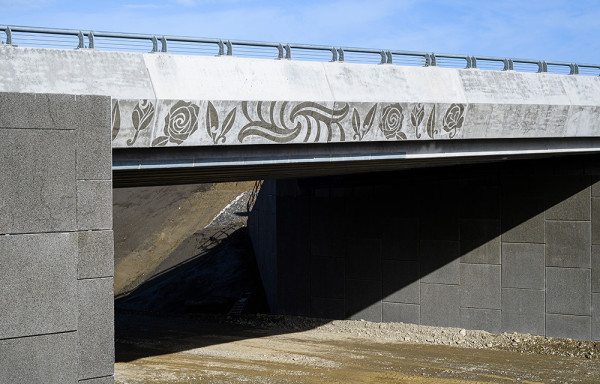
Bridge 7 Ōtaki Gorge Road artwork on northern side.
The importance of planting alongside PP2Ō
As you travel alongside the PP2Ō Expressway, you’ll notice that our planting is starting to take shape - literally! The range of species planted along the Expressway corridor are there not only for landscape mitigation or to blend the road into the surroundings, but also to optimise environmental benefits. While these native plants may be aesthetically pleasing to look at, they have also been chosen because of their self-sustaining, adaptable and robust characteristics. The native plants also provide the benefit of increasing habitat extents for native fauna throughout both existing habitats and new ecological mitigation sites.
Planting on the project started in July 2019. With approximately 750,000 plants to be planted along the Expressway, the logistics had to be carefully planned. Community involvement has always been important for this project, and a number of local schools have been involved in the planting process. Ōtaki College students were provided with seedlings from the Fletcher project team, and the college’s horticulture department has been growing them at their facilities. Planting across the project is designed to create a green corridor that enhances and accentuates the unique character of the area, while speaking to the importance of the history and culture of the Kāpiti region.
In areas where we’ve had to remove vegetation, it’s either been replaced with new plants in the same area or re-planted elsewhere. Our planting scope includes a minimum of:
- 38ha of native landscape planting
- 1.1ha of wetland planting, including restoration of swamp forest and wetland habitat
- 1.5ha of indigenous terrestrial forest species, and
- 2.6km of riparian planting.
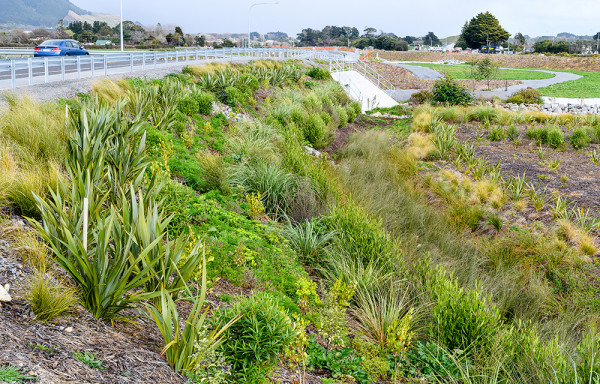
Wetlands and planting around Bridge 8 Te Horo Beach Road overbridge.
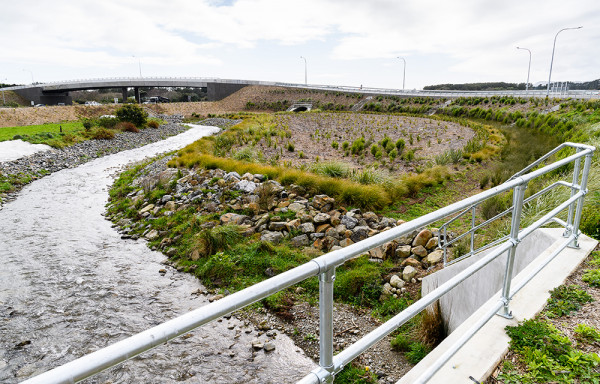
Planting around Bridge 8 Te Horo Beach Road overbridge.
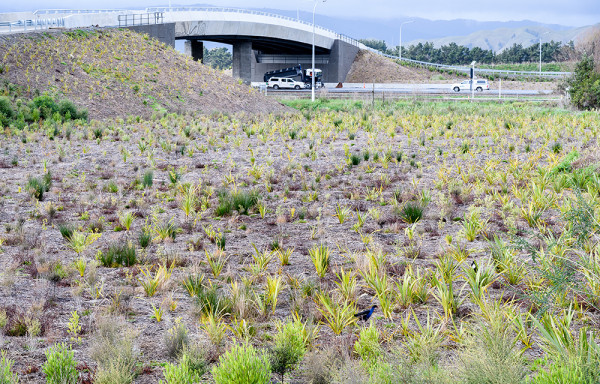
Planting around Bridge 8 Te Horo Beach Road overbridge.
We're seeking your time capsule submissions!
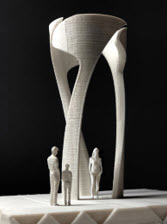
Submissions are open for items to be placed in the time capsule.
Much of what we know about our history has come from artefacts that tell stories of our ancestors. If you could leave a piece of Ōtaki to be discovered by future generations – what would it be?
PP2Ō is seeking submissions for items to be included in a time capsule. The time capsule will be placed underneath one of the Interchange Gateway Sculptures that will be gifted to the community as part of the project. The time capsule theme is ‘Your Ōtaki – what Ōtaki means to you’. This includes contemporary views, historic documents and artefacts that provide insights into how Ōtaki came to be, the place it is today and what it means to the community.
Anything placed in the time capsule must be dry and non-perishable, so items made from materials like paper, plastic and glass may work best. “Think broadly” is the request from the project team.
If you would like to submit an item to be considered for the time capsule, please email pp2o@nzta.govt.nz.
Upcoming construction milestones
Northern area update
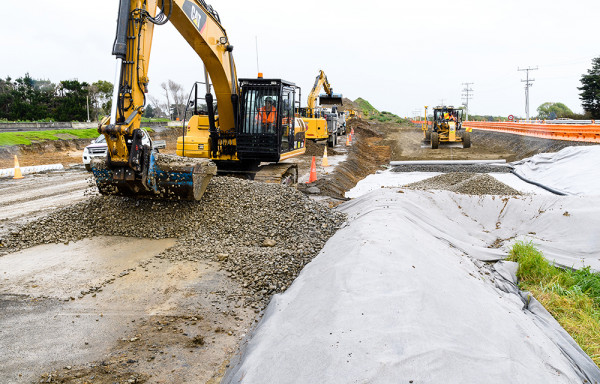
Site just north of Bridge 1 over Waitohu Stream adjacent to Taylors Road.
Now that we have switched both northbound and southbound traffic onto the temporary section of road, work can progress at the northern end of the project. Culvert 1 will carry the Greenwood Stream (Wai-o-rangi), which is programmed for completion this summer, and the bulk earthworks between Taylors Road and Bridge 1 (Waitohu Stream Bridge) are expected to be largely completed before the Christmas 2021 closedown period.
Central area update
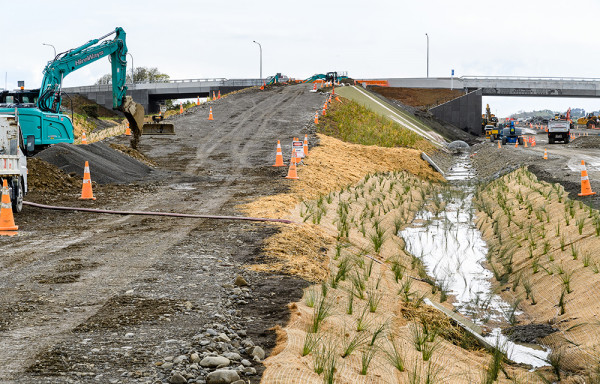
Site immediately south of Ōtaki Gorge Road.
Winiata Link Road drainage and utility works are expected to be completed this summer. The wire rope barrier installation and ITS (Intelligent Transport System) foundations are progressing well towards completion.
Southern area update
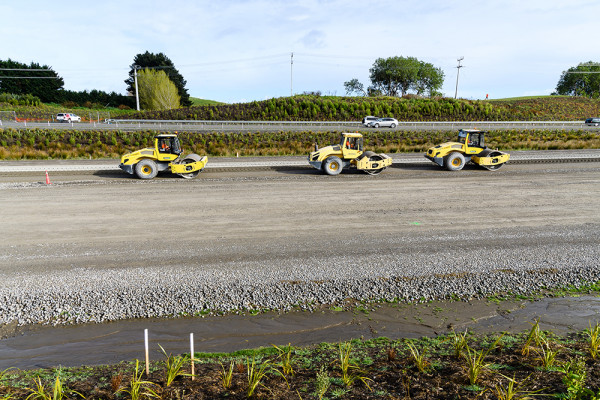
Area south of Makahuri cement stabilising.
Works on Bridge 9 (Makahuri Rail Overbridge) are now complete, including the last concrete pour and barrier installations. The Expressway mainline footprint south of the bridge is now ready for putting down the asphalt layers.